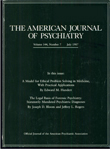Acute Stress Disorder as a Predictor of Posttraumatic Stress Symptoms
Abstract
OBJECTIVE: Using the DSM-IV diagnostic criteria for acute stress disorder, the authors examined whether the acute psychological effects of being a bystander to violence involving mass shootings in an office building predicted later posttraumatic stress symptoms. METHOD: The participants in this study were 36 employees working in an office building where a gunman shot 14 persons (eight fatally). The acute stress symptoms were assessed within 8 days of the event, and posttraumatic stress symptoms of 32 employees were assessed 7 to 10 months later. RESULTS: According to the Stanford Acute Stress Reaction Questionnaire, 12 (33%) of the employees met criteria for the diagnosis of acute stress disorder. Acute stress symptoms were found to be an excellent predictor of the subjects' posttraumatic stress symptoms 7–10 months after the traumatic event. CONCLUSIONS: These results suggest not only that being a bystander to violence is highly stressful in the short run, but that acute stress reactions to such an event further predict later posttraumatic stress symptoms.



